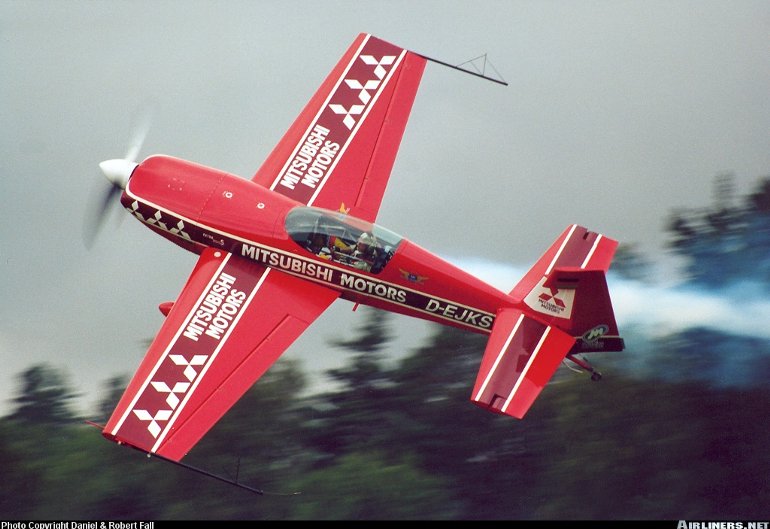Aircraft Technical Data
Extra 230, 300 & 200

| Details | |
| Country of Origin | Germany |
| Type | Unlimited competition aerobatic aircraft |
| History | Extra's aerobatic light aircraft were designed from the outset for unlimited aerobatic competition flying. The original wooden wing Extra 230 was designed by company founder Walter Extra to meet the requirements of competition pilots with the Swiss Aero Club. First flight occurred during 1983. Unusually for an aircraft of its type the Extra 230 features a wooden wing with dacron covering, while as on other aerobatic competition aircraft the 230's wing has 0° incidence for sustained inverted flight. Production ceased in 1990 when Extra was experiencing difficulties in sourcing the correct type of wood. Design work on the larger, two seat Extra 300 began in early 1987, culminating in the first flight of a prototype on May 6 1988 and certification in May 1990. Production began in October 1988. Small numbers of Extra 260s were also built in the early 1990s. These aircraft were essentially downsized Extra 300s with seating for a pilot only and powered by a 195kW (260hp) IO540 flat six. The Extra 260 was not certificated, the six that were built were able to fly under special permits. The single seat Extra 300S first flew on March 4 1992 and was certificated that same month. The 300S differs from the 300 in having a single seat, shorter span wings and more powerful ailerons, while retaining the same powerplant and basic fuselage. The 300L has a low mounted wing. The strengthened 330 has a 245kW (330hp) AEIO-580 and larger control surfaces, and first flew in January 1998. Both the 300 and 300S are stressed for +10/10g flight with a single pilot, have additional transparencies in the lower sides of the fuselage below the wings for pilot visibility, and a single piece canopy. Extra's latest product is the 150kW (200hp) AEIO360 powered Extra 200 two seater. It first flew in April 1996. Of similar construction to the 300, it replaces the earlier 230. |
| Powerplants | 230 - One 150kW (200hp) Textron Lycoming AEIO360 flat four piston engine driving a two blade c/s Mühlbauer propeller. 300 - One 225kW (300hp) Textron Lycoming AEIO540L1B5 flat six driving a three (or optionally four) blade Mühlbauer c/s prop. |
| Performance | 230 - Max speed 352km/h (190kt). Initial rate of climb 2950ft/min. Endurance with max fuel 2hr 30min. 300 - Max speed 343km/h (185kt), max manoeuvring speed 293km/h (158kt). Initial rate of climb 3300ft/min. Range with reserves 974km (526nm) |
| Weights | 230 - Empty 440kg (970lb), max takeoff 560kg (1235lb). 300 - Empty 630kg (1389lb), max aerobatic takeoff 870kg (1918lb), max takeoff 950kg (2094lb). |
| Dimensions | 230 - Wing span 7.40m (24ft 3in), length 5.82m (19ft 2in), height 1.73m (5ft 8in). 300 - Wing span 8.00m (26ft 3in), length 7.12m (23ft 4in), height 2.62m (8ft 7in). Wing area 10.7m2 (115.17sq ft). 300S - Same except for wing span 7.50m (24ft 7in), length 6.65m (21ft 9in). Wing area 10.4m2 (112sq ft). |
| Capacity | 300 and 200 seat two, 230 and 300S seat pilot only. |
| Production | Extra 230 production ceased in 1990. Approximately 170 Extra 300s delivered since 1988, 25 200s since 1996. |
| Related Links | Extra 230, 300 & 200 |
The backbone of this section is from the The International Directory of Civil Aircraft by Gerard Frawley and used with permission. To get your own copy of the book click here. |
|








